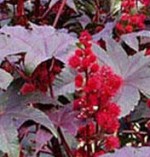 Castor bean is native to Africa, Middle East and India but has naturalized all over the world in subtropical and tropical areas where it can be found in disturbed areas such s roadsides and along railroads. It is very fast growing and quickly becomes a suckering shrub or small tree. The very large (up to 30 inches across) palmately lobed leaves are borne on long petioles attached to the center of the leaf. In the Middle Ages the leaves were thought to resemble a hand so the plants were called “palma Christi”, “hand of Christ’. The leaves may be green, red, or variegated. Male and female flowers lack petals and are borne in terminal panicles with female flowers at the top and male flowers below in mid- to late summer. The male flowers have conspicuous yellow anthers while the female flowers have conspicuous red stigmas. The fruit is a spiny ovoid capsule that explosively releases three flattened ripe seeds that resemble ticks. Plants are well branched with watery reddish-purple stems. Although a perennial in warm climates, castor bean is widely grown as an annual in cooler climates where it can add a tropical look to the landscape. All parts of the plant especially the seeds are highly toxic so the plants should not be grown where children are likely to have access to them. The genus name, Ricinus, is the classical Latin word meaning tick and refers to the appearance of the seeds. The genus name, communis, is the classical Latin word meaning common and refers to the distribution of the plant.
Castor bean is native to Africa, Middle East and India but has naturalized all over the world in subtropical and tropical areas where it can be found in disturbed areas such s roadsides and along railroads. It is very fast growing and quickly becomes a suckering shrub or small tree. The very large (up to 30 inches across) palmately lobed leaves are borne on long petioles attached to the center of the leaf. In the Middle Ages the leaves were thought to resemble a hand so the plants were called “palma Christi”, “hand of Christ’. The leaves may be green, red, or variegated. Male and female flowers lack petals and are borne in terminal panicles with female flowers at the top and male flowers below in mid- to late summer. The male flowers have conspicuous yellow anthers while the female flowers have conspicuous red stigmas. The fruit is a spiny ovoid capsule that explosively releases three flattened ripe seeds that resemble ticks. Plants are well branched with watery reddish-purple stems. Although a perennial in warm climates, castor bean is widely grown as an annual in cooler climates where it can add a tropical look to the landscape. All parts of the plant especially the seeds are highly toxic so the plants should not be grown where children are likely to have access to them. The genus name, Ricinus, is the classical Latin word meaning tick and refers to the appearance of the seeds. The genus name, communis, is the classical Latin word meaning common and refers to the distribution of the plant.
Type: Perennial in zones 8-11; grown as annual elsewhere
Outstanding Feature: Foliage, flowers
Form: Upright, variable
Growth Rate: Rapid
Bloom: Small apetalous male and female flowers borne in terminal panicles in mid- to late summer with female flowers at the top and male flowers below;
Size: 8-12’ H x 8-12’ W
Light: Full sun
Soil: Average, moist; tolerates some drought once established but does not grow as rapidly
Hardiness: Zones 8-11
Care: Low maintenance
Pests and Diseases: None of significance
Propagation: Seed
Outstanding Selections:
-
- ‘Carmencita’ (bronze leaves, bright red flowers and fruit; 5-6’ tall)
-
- ‘Gibsonii’ (dwarf, 3-4’ H; leaves purple red with metallic luster)
-
- ‘Impala’ (5-6’ H; maroon to carmine new growth; flowers sulfur-yellow)
-
- ‘Sanguineus’ (dark red to burgundy leaves)
-
- ‘Scarlet Queen’ (burgundy leaves; bright orange-red flowers)
- ‘Zanzibarensis’ (Exceptionally large, green leaves)
